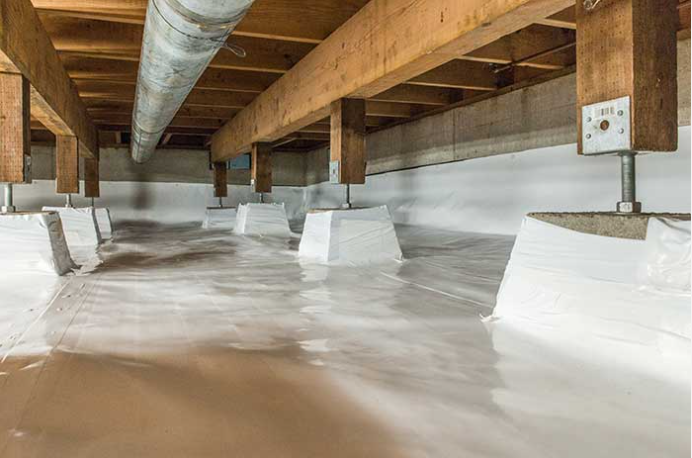Crawlspaces are common in Portland homes, and they are a secret weapon in home energy efficiency. Like a basement, a crawlspace elevates your home off the ground, provides a convenient and inconspicuous place to contain the “guts” of the house (HVAC ducts, plumbing, electrical wiring), and provides habitat for spiders. It can also steal up to 25% of your home’s conditioned air! Read on to learn how to improve your Home Energy Score by crawling into the clammy, dark space beneath the floor.
Portland Crawlspaces: To seal or not to seal?
For most crawlspaces, ventilation is key to avoiding mold and moisture buildup underneath your house. Mold spores are unhealthy to breathe, and moisture itself can lead to rot — not something you want in the floor joists holding up the house. In addition, moisture can creep up through the home, which is not only uncomfortable for you, but can lead to all of the above problems happening not just in the crawlspace but in the walls and ceilings of the entire house.
Pros and Cons for Sealed Portland Crawlspaces
So, why would we even suggest sealing a crawlspace? Well, if done correctly, sealing a crawlspace can greatly improve home energy efficiency. Instead of having the space beneath your home at roughly the same temperature as the outdoors, you have an opportunity to create an insulated space that can help keep your home cooler in the summer, and warmer in the winter.
Four Steps to a Well-Sealed Crawlspace
When you consult with a contractor to seal your crawl space, they should, at the minimum, perform the following tasks:
- Install a vapor barrier. A large plastic sheet covering the dirt floor of your crawl space will reduce the moisture coming up from the ground. For a crawl space “encapsulation”, the barrier will be sealed with tape and extend up the walls of the crawlspace.
- Control moisture. All Portland crawlspaces have some degree of moisture. For many, a sump pit and pump is a good idea. The pit serves to collect water; the sump pump pumps it out. Even if there’s no moisture intrusion now, a sump pump will come in handy if there’s ever a plumbing leak that causes water to collect down in the crawl space. Your contractor may also recommend a dehumidifiers to remove moisture from the air, collecting it as water which can then be drained away from the house.
- Create the “conditioned space”. A sealed crawlspace needs to be reached by the HVAC system, or have its own system of air circulation and an exhaust vent so that some air can move in and out.
- Upgrade insulation. Once the crawlspace has been sealed and the moisture issue solved, wall insulation will further improve energy efficiency. Regular batt insulation, foam board or spray foam insulation may be used in a crawlspace.
Sealing a crawl space is not a job to be taken lightly. Here’s a quote from an architect: “If you have to have a crawlspace, then make it completely open or make it completely sealed. It’s the typical in-between crawl space that is the real trouble. I could show you several really gross photos of what I have found in crawl spaces, living and dead, but maybe you will just take my word on this one.” – Mark McLain, Confluence Architecture.
Other Home Safety Considerations for Portland Crawlspaces
- Seismic retrofitting: It’s recommended that homes with cripple walls be bolted to the foundation, because of Portland’s earthquake risk. This project should be done before sealing and insulating the crawlspace.
- Radon mitigation: The ground beneath Portland has many areas that are high in radon, which can migrate through the home and is the second-leading cause of lung cancer in the US. One radon mitigation solution involves placing a plastic sheet on the round, so many crawlspace sealing projects can double as radon mitigation. But if radon levels in your home are high (run a test first), the project needs to be altered to ensure that it is actually blocking radon and giving it some place to go (an exterior vent). For more, check out this article on Ecohome.
To learn more about crawlspace sealing, check out the US Department of Energy website, which has a comprehensive list of resources.
Energy Efficiency Tips for Vented Crawlspaces
Many Portland homeowners end up deciding that the trouble is not worth the benefits of sealing their crawlspace. However, there are still some things you can do to improve your home’s energy efficiency, and your Home Energy Score, in a well vented crawlspace.
- Start with a vapor barrier. You don’t have to completely encapsulate your crawlspace to see some benefit from moisture reduction by placing a plastic sheet over the ground. Cut it to fit the footprint of your crawlspace, and use tape to secure it.
- Seal and insulate HVAC ducts. The average home loses about 20-40% of heated or cooled air through leaky ducts, and many of those ducts run through the crawlspace. Use duct mastic or foil-backed mastic tape to seal leaks, as well as all seams and joints in the ductwork. Then wrap them in fiberglass batts. For more, check out our Portland DIY Guide on Duct Sealing and Insulation.
- Air seal the subfloor. To prevent unconditioned air from moving up into your home from the crawlspace through the first-story floor, we recommend air sealing. Use a spray foam in cracks between the floor joists, rim joists and the subfloor. Use foam board or fiberglass batts for larger gaps. Also look for exhaust flues and ducting registers and seal those gaps, too. Here’s a great Department of Energy guide to subfloor sealing and insulation. Note: There’s no need to air seal your subfloor if you have encapsulated your crawl space, since the air below the floor will also be heated.
Not sure what to do with your crawlspace to maximize energy efficiency? Need to talk to a home energy expert? Schedule your Home Energy Score report with us today!

